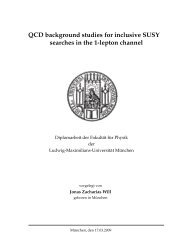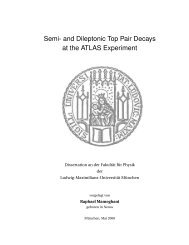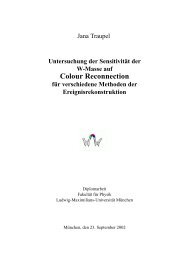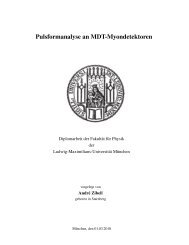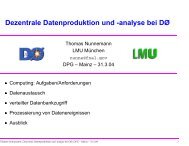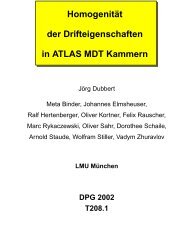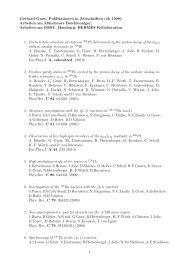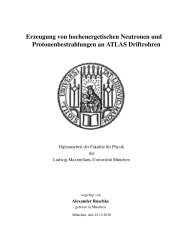development of micro-pattern gaseous detectors – gem - LMU
development of micro-pattern gaseous detectors – gem - LMU
development of micro-pattern gaseous detectors – gem - LMU
You also want an ePaper? Increase the reach of your titles
YUMPU automatically turns print PDFs into web optimized ePapers that Google loves.
24 Chapter 2 The GEM Principle<br />
mobility <strong>of</strong> ions is about hundred to thousand times smaller than for electrons, the former stay along<br />
the field lines and are collected by the top electrode <strong>of</strong> the foil. In an optimal process they will reach<br />
neither the drift nor the induction gap. In reality there may be a fraction <strong>of</strong> ions which escape into<br />
the gap regions resulting in an induced current at the cathode. This defines the ion feedback to be the<br />
ratio <strong>of</strong> induced charges at the drift electrode owing to ions and the desired induced signal caused<br />
by electrons at the anode [Simo 01]. In this way space charge effects are reduced to a minimum.<br />
On account <strong>of</strong> this ion suppression that results in an achievable excellent spatial resolution, GEMs<br />
are used in a wide range <strong>of</strong> implementations from particle physics over astrophysics to medical<br />
applications [Saul 03].<br />
2.3 Multiple GEMs<br />
Multiple GEM <strong>detectors</strong> are already used in several experimental setups. For instance, a lot <strong>of</strong><br />
research on GEM <strong>detectors</strong> was done for the COMPASS 2 experiment at CERN since they represent<br />
an important fraction <strong>of</strong> the installed tracking devices. This detector investigates hadron structure and<br />
hadron spectroscopy by running in high intensity muon and hadron beams [Ketz 04] and [Ketz 03].<br />
Discharges that may occur inside a GEM foil or even propagating all the way from the GEM electrode<br />
to the readout structure are a serious concern. Initiated by heavily ionizing particle, these local<br />
currents cause a voltage breakdown that may result in destruction <strong>of</strong> detector material or readout<br />
devices.<br />
In order to attain detectable amounts <strong>of</strong> charges for the readout, one can multiply the effect <strong>of</strong> the<br />
GEM by using several GEM foils in a stack. In such an assembly, the uppermost GEM acts as an<br />
amplifying stage for the subsequent foils, increasing the overall gas gain to the power <strong>of</strong> installed<br />
GEMs. For instance, in view <strong>of</strong> a triple GEM configuration and a given gain G ≈ 20 per foil, the<br />
total primary charge is amplified by a factor <strong>of</strong> 20 3 = 8000 [Murt 02], depending on the applied<br />
voltages and used gas mixture.<br />
The performance <strong>of</strong> GEM <strong>detectors</strong> in high irradiation environment and the corresponding discharge<br />
probability is studied intensely by Bachmann et al., for instance in [Bach 01a] and [Bach 01b].<br />
Measurements with single and multiple GEM foils in a detector under alpha particle irradiation<br />
indicate that for a given gain the discharge probability reduces the most for a setup <strong>of</strong> three GEM<br />
foils [Bach 02]. Fig. 2.5 shows how the effective gain <strong>of</strong> a particular GEM detector increases by<br />
approximately an order <strong>of</strong> magnitude per added foil without affecting the discharge probability<br />
significantly. By considering a desired gain <strong>of</strong> G = 4000 the double GEM structure reports a<br />
discharge probability <strong>of</strong> 0.09 × 10 −2 which corresponds to an already serious rate. Taking triple<br />
GEM detector decreases the discharge probability under the measurable limit <strong>of</strong> 6 × 10 −6 .<br />
These results are based on data taken for <strong>detectors</strong> filled with Ar/CO2 at a ratio <strong>of</strong> 70/30 and with<br />
241 Am as an irradiation source that provided collimated α-particles at a frequency <strong>of</strong> approximately<br />
100 Hz. The electric fields applied in a multiple GEM detector can be decreased in comparison<br />
to single GEM <strong>detectors</strong> by still reaching higher and safe gain. Additionally it was found that the<br />
total gain can be further increased by cascading the voltage across the foils with the uppermost foil<br />
at the highest voltage difference (see Ch. 3.2). Although the gas volume <strong>of</strong> the detector has to be<br />
2 COmmon Muon and Proton Apparatus for Structure and Spectroscopy



